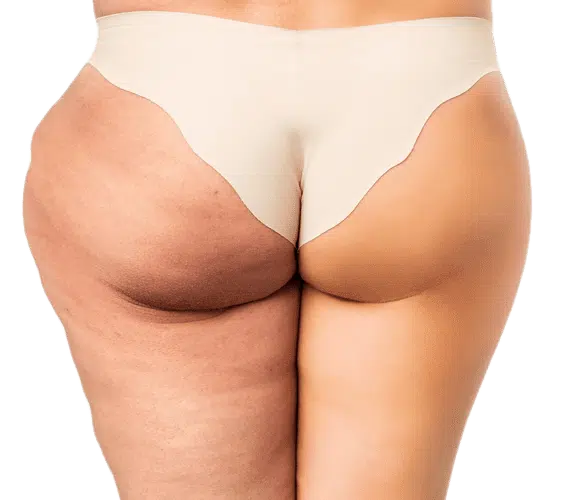You have the typical complaints and ask yourself: “Do I have lipedema?”
You are not alone in this. Lipedema is now on everyone’s lips and fortunately is thus getting the necessary attention it has long deserved. Socially, politically, and medically.
Finally, there are explanations for “too fat legs” and “painful arms”. The most used synonym, pathological fat distribution disorder, does not adequately describe lipedema in its complexity, but it does arouse curiosity to learn everything there is to know about lipedema. Here we share with you our entire experience from thousands of successful lipedema operations and hope to be able to give you a good overview of the clinical picture of lipedema.
You can get extensive information about the common complaints and symptoms here at your leisure. In the first steps, you can even find out for yourself to what extent your situation corresponds to the common criteria for the diagnosis of lipedema. If you suspect that you have lipedema, you are welcome to come to our clinic for a live consultation. There we can examine your situation even more deeply and extensively.
At what point is my situation with lipedema pathological?
At what point do I need surgical help?
People affected by lipedema are not simply too fat through their own fault! On the contrary: due to unknown causes, with a corresponding genetic predisposition, there are increased and enlarged fat cells between the skin and the muscles, which trigger pain due to the resulting pressure and increased inflammatory processes. We define the lipedema cells as those fat cells that cannot be influenced by sport or diet and therefore cannot decrease in size or number during the disease.
Recognising Lipedema
We have summarized the most important indications of lipedema for you here. If you can answer many of the 20 questions with “yes”, you should then take our lipedema self-test from med-plast directly. Due to its algorithm, this is even more specific in its evaluation for a possible diagnosis of lipedema.
We then analyze to what extent your information matches our scientific findings and our experience with the clinical picture of lipedema. In combination with the exclusion of other possible causes for your symptoms and your individual course, we can make a tentative diagnosis of lipedema.
At present, there are no diagnostic possibilities through imaging such as ultrasound, MRI, or CT. A biopsy or blood test does not help either. – Not yet – because a lot of research is being done worldwide to be able to confirm the diagnosis of lipedema with a so-called biomarker. Until then, we only have the clinical signs such as symptoms, complaints, and the typical course of the disease as clues to a possible lipedema disease. Here you can read more about our clinical diagnosis of lipedema.
With lipedema
soft wave
pressure painful
cool skin
bruises

Without lipedema
smooth
painless
well supplied with blood
homogeneous colour
20 Indications of lipedema
- Development: Have you suffered from “thicker legs” since puberty?
- Skin: Does the skin no longer feel smooth?
- Distribution pattern: Is there a symmetrical fat distribution despite your complaints?
- Hands and feet: Are these typically not affected by the swelling?
- Pain: Do you suffer from sensitivity to pressure and touch?
- Progression: Did hormonal changes, such as pregnancy, cause an increase in symptoms?
- Sport and diet: Did exercise and a conscious diet have no noticeable effect?
- Bruises: Do you often have bruises and don’t know where they come from?
- Heredity: Are other family members affected by swelling of the extremities?
- Doctors: Have you already consulted several doctors, but without the desired success?
- Swelling: The longer you stand and the warmer it is, the greater the swelling of the lower legs at the end of the day?
- Cold skin: Does your skin on the thighs stay cold for a long time after you come out of the cold into a warm environment?
- Oedema: Does NO dent remain when you press deep into the thickened tissue with your finger?
- Typical pain points: Do the inner knees, outer thighs and lower upper arms hurt most when pressure is applied?
- Skin connective tissue: Do your legs look better when sitting than when standing due to skin tension?
- Abdomen: Do you feel painful nodules in the depth of the lower abdomen?
- Pinchtest: is there a higher intensity of pain in the tissue between two fingers than with pressure from only one finger?
- Arms: Is there fatigue pressure in the arms when they are held up for a longer period of time?
- Muff formation: Do the undesirable changes already start from the wrists or from the ankle regions?
- Flat knit: Can you relieve your discomfort with flat knit compression pants?
If you answered “yes” to more than 13 questions, there is a high probability that you have lipedema.
As the next step, we recommend our self-test from med-plast. This is even more specific and directly evaluates your questions through our algorithm.
If this is positive and you yourself strongly suspect lipedema, we will be happy to clarify your individual situation together with all the necessary examinations in our med-plast clinic.
For a more differentiated assessment, you can also carry out our med-plast lipedema self-test. This only takes 3 minutes.
For a detailed consultation with our plastic surgeons, you are also welcomed to come directly to our lipedema clinic in Berlin or make an online appointment.
NUMBERS AND FACTS
Up to 10% of all women in Germany suffer from the disease "lipedema".
It takes an average of 10 years before a diagnosis is made.
med-plast Berlin performs more than 1,000 lipedema operations per year.



